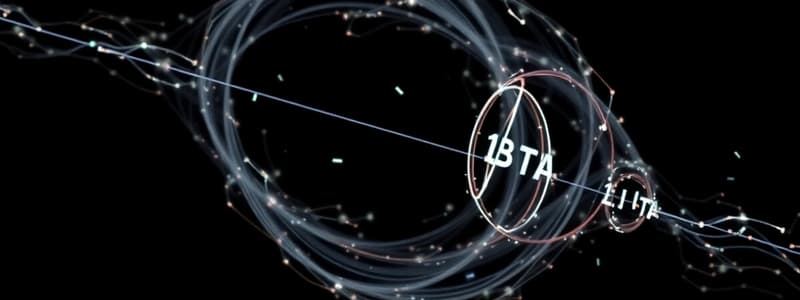Podcast
Questions and Answers
What does Newton's first law of motion state?
What does Newton's first law of motion state?
- An object at rest will eventually move on its own.
- An object remains at rest or in motion only if acted upon by a balanced force.
- An object at rest stays at rest and an object in motion stays in motion unless acted upon by an unbalanced force. (correct)
- An object in motion will stop unless acted upon by an unbalanced force.
Which equation represents Newton's second law of motion?
Which equation represents Newton's second law of motion?
- F = m/a
- F = m + a
- F = ma (correct)
- F = mv^2
What is conveyed by the law of conservation of energy?
What is conveyed by the law of conservation of energy?
- Energy can fluctuate in an isolated system based on external forces.
- Energy can be created under certain conditions.
- Energy is lost when processes occur that change its form.
- Energy can neither be created nor destroyed, only transformed from one form to another. (correct)
Which law of thermodynamics states that the total entropy of an isolated system can only increase over time?
Which law of thermodynamics states that the total entropy of an isolated system can only increase over time?
Which of the following processes is NOT a thermodynamic process commonly recognized?
Which of the following processes is NOT a thermodynamic process commonly recognized?
What is the relationship between electric charges and magnetic fields as described in electromagnetism?
What is the relationship between electric charges and magnetic fields as described in electromagnetism?
What is one of the main principles outlined by the first law of thermodynamics?
What is one of the main principles outlined by the first law of thermodynamics?
Which mechanism is NOT a method of heat transfer?
Which mechanism is NOT a method of heat transfer?
Which of the following best explains the significance of Maxwell's equations?
Which of the following best explains the significance of Maxwell's equations?
What is the primary focus of optics?
What is the primary focus of optics?
What does Heisenberg's uncertainty principle illustrate?
What does Heisenberg's uncertainty principle illustrate?
Which application is directly associated with general relativity?
Which application is directly associated with general relativity?
In the context of optics, diffraction refers to:
In the context of optics, diffraction refers to:
What best describes wave-particle duality in quantum mechanics?
What best describes wave-particle duality in quantum mechanics?
Length contraction is a phenomenon predicted by which theory?
Length contraction is a phenomenon predicted by which theory?
What type of optical instruments is used to manipulate light to form images?
What type of optical instruments is used to manipulate light to form images?
Flashcards
Newton's First Law
Newton's First Law
Newton's First Law states that an object at rest will remain at rest, and an object in motion will remain in motion at a constant velocity unless acted upon by an unbalanced force.
Newton's Second Law
Newton's Second Law
Newton's Second Law states that the acceleration of an object is directly proportional to the net force acting on it and inversely proportional to its mass. This is often represented by the formula F=ma.
Newton's Third Law
Newton's Third Law
Newton's Third Law states that for every action, there is an equal and opposite reaction. This means that forces always occur in pairs.
First Law of Thermodynamics
First Law of Thermodynamics
Signup and view all the flashcards
Second Law of Thermodynamics
Second Law of Thermodynamics
Signup and view all the flashcards
Third Law of Thermodynamics
Third Law of Thermodynamics
Signup and view all the flashcards
Electromagnetic Waves
Electromagnetic Waves
Signup and view all the flashcards
Electromagnetism
Electromagnetism
Signup and view all the flashcards
Maxwell's Equations
Maxwell's Equations
Signup and view all the flashcards
Optics
Optics
Signup and view all the flashcards
Refraction
Refraction
Signup and view all the flashcards
Diffraction
Diffraction
Signup and view all the flashcards
Quantum Mechanics
Quantum Mechanics
Signup and view all the flashcards
Heisenberg's Uncertainty Principle
Heisenberg's Uncertainty Principle
Signup and view all the flashcards
Special Relativity
Special Relativity
Signup and view all the flashcards
General Relativity
General Relativity
Signup and view all the flashcards
Study Notes
Classical Mechanics
- Classical mechanics describes the motion of macroscopic objects, such as planets and cars, using concepts like Newton's laws of motion.
- Newton's first law states that an object at rest stays at rest and an object in motion stays in motion with the same speed and in the same direction unless acted upon by an unbalanced force.
- Newton's second law states that the acceleration of an object is directly proportional to the net force acting on it and inversely proportional to its mass. (F = ma)
- Newton's third law states that for every action, there is an equal and opposite reaction.
- Concepts such as inertia, momentum, and energy are fundamental to understanding motion in classical mechanics.
- Force, mass, and acceleration are central concepts in mathematical formulations of force.
- Work and energy principles are widely used for calculating effects or changes in mechanical systems.
- Conservation of energy and momentum are key concepts that hold true in closed systems, where no external forces are applied.
Thermodynamics
- Thermodynamics deals with heat, work, and temperature and their relationship to energy and entropy.
- The laws of thermodynamics govern the behavior of thermal systems.
- The first law of thermodynamics states that energy can neither be created nor destroyed, only changed from one form to another.
- The second law of thermodynamics states that the total entropy of an isolated system can only increase over time.
- The third law of thermodynamics states that the entropy of a system approaches a constant value as the temperature approaches absolute zero.
- Thermodynamic processes like isothermal, adiabatic, isobaric, and isochoric processes are used to describe how systems exchange heat and work with their surroundings.
- Important concepts like enthalpy and specific heat capacity in thermodynamics.
- Heat transfer mechanisms (conduction, convection, and radiation) are also important subsets of thermodynamics.
Electromagnetism
- Electromagnetism deals with the forces and interactions between electric charges and magnetic fields.
- Electric charges create electric fields which exert forces on other charges.
- Magnetic fields are created by moving electric charges and exert forces on moving charges.
- Electromagnetic waves are disturbances in electric and magnetic fields that travel through space at the speed of light. Examples include visible light, radio waves, microwaves, X-rays, etc.
- Maxwell's equations are fundamental to describing electromagnetic phenomena. They relate electric and magnetic fields to their sources and to each other.
- Important applications include electric motors, generators, and transformers.
Optics
- Optics deals with the behavior and properties of light, including reflection, refraction, diffraction, and interference.
- Laws of reflection and refraction govern how light interacts with surfaces.
- Lenses and mirrors are used to manipulate light and form images.
- Diffraction patterns occur when light passes through narrow openings or around obstacles.
- Interference patterns arise from the superposition of light waves.
- Understanding of light's wave nature and particle nature.
- Types of optical instruments, like telescopes and microscopes, are discussed.
Quantum Mechanics
- Quantum mechanics describes the behavior of matter and energy at the atomic and subatomic level.
- Fundamental particles and their properties are studied in detail.
- Heisenberg's uncertainty principle is crucial in quantum mechanics, highlighting the inherent limitations in simultaneously measuring certain pairs of physical properties.
- Concepts such as wave-particle duality and superposition are central to understanding quantum phenomena.
- Quantum mechanics provides the foundation for understanding atomic structure, chemical bonding, and nuclear physics among other phenomena.
- Applications in modern technology include transistors and lasers.
Relativity
- Relativity encompasses the theories of special and general relativity, which revolutionized our understanding of space, time, and gravity.
- Special relativity describes the relationship between space and time in the absence of gravity.
- General relativity describes gravity as a curvature of spacetime caused by mass and energy.
- Key concepts include the speed of light being constant for all observers, time dilation, length contraction, and the equivalence of mass and energy.
- Applications include GPS technology, and understanding cosmic phenomena such as black holes and the expansion of the universe.
Studying That Suits You
Use AI to generate personalized quizzes and flashcards to suit your learning preferences.




